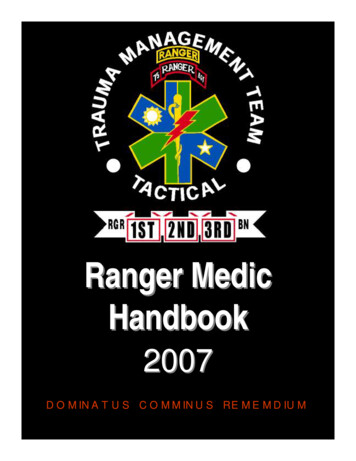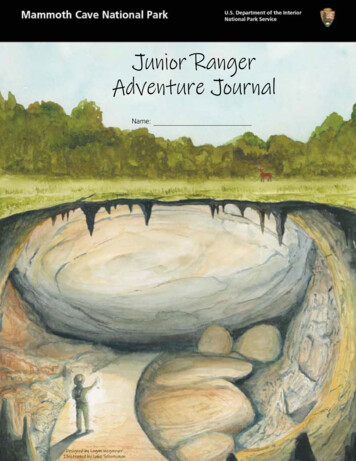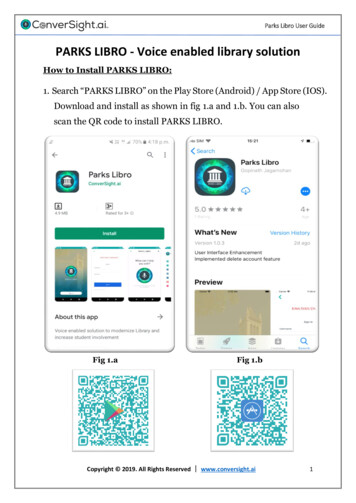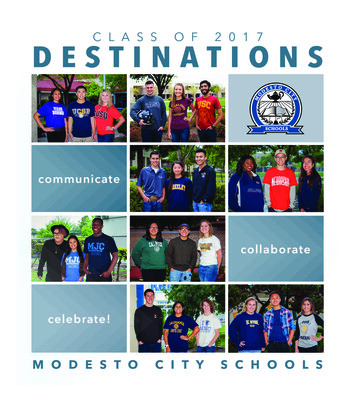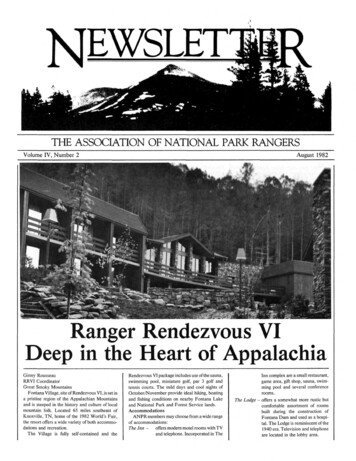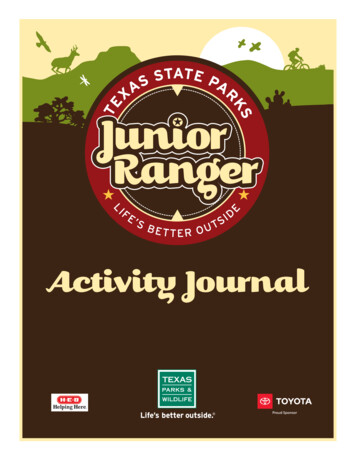
Transcription
Activity Journal1
This Journal belongs to:Junior Rangers:Learn how to protect the park’s plants and animals.Teach their families and friends about the park.Follow park rules, protect the park and stay safe. 2020 TPWD PWD BK P4000-2028 (3/20)TPWD receives funds from the USFWS. TPWD prohibits discrimination on the basis of race, color, religion, national origin, disability, age, and gender, pursuant to state and federal law. Torequest an accommodation or obtain information in an alternative format, please contact TPWD on a Text Telephone (TTY) at (512) 389-8915 or by Relay Texas at 7-1-1 or (800) 735-2989 orby email at accessibility@tpwd.texas.gov. If you believe you have been discriminated against by TPWD, please contact TPWD, 4200 Smith School Road, Austin, TX 78744, or the U.S. Fish andWildlife Service, Office for Diversity and Workforce Management, 5275 Leesburg Pike, Falls Church, VA 22041.In accordance with Texas State Depository Law, this publication is available at the Texas State Publications Clearinghouse and/or Texas Depository Libraries.
Welcome, Parents and Adult Leaders!We are delighted that you and your family or group areparticipating in our Junior Ranger program. The goal of thisprogram is to encourage thoughtful fun, exploration, discovery,wonder and appreciation of Texas State Parks’ natural andcultural resources. Working through the journal is a great wayto spend time with your kids out in nature. It will also help themappreciate the importance and value of YOUR Texas State Parks.You don’t need to be an expert to help your child become a juniorranger. Your enthusiasm and encouragement are what mattermost of all. If you need help with any of the activities, feel free toask a park staff member.Kids can keep this journal as a souvenir of their visit to a Texasstate park. Present a completed journal to the office to receive aJunior Ranger Badge.Have fun and we will see you in the parks!Sincerely,The Staff at Texas State Parks3
How to become a Junior RangerThis journal will help you become a Junior Ranger by exploring Texas StateParks. Every state park is different. Each has its own plants, animals, historyand environment (such as desert or forest). Each has its own fun things to do,like hike, swim or climb.Check off activities to earn your Junior Ranger badge. Visit more parks toearn more badges!LevelLevelLevelAges 6-7, mustcomplete at leastactivitiesAges 8-10, mustcomplete at leastactivitiesAges 11-12, mustcomplete at leastactivities152739Junior Ranger Checklist4Staying Safe, pg. 5Life’s Better Outside, pg. 16Leave No Trace, pg. 6Nature’s Recyclers, pg. 18Be Wise with Water, pg. 8Explore the Past, pg. 20Observing Wildlife, pg. 10What Does a Park Ranger Do?, pg. 22Park Poetry, pg. 12Ranger Pledge, pg. 23Dark in the Park, pg. 14
Staying SafeJunior Rangers know how to be safe in wild places.Park rules keep you safe. Park rules also protect the park and its wildlife.Listen carefully while a grown-up reads these rules to you. Talk about whythe rules are important. Once you’ve finished, your grown-up can then puthis/her initials on your checklist.1. Be prepared. Wear the right clothes and shoes for your outdoor activity. Dress in layers.Then you can remove or add clothes to stay comfortable. Know your strengths andweaknesses. Before hiking a trail, find out how long and how difficult it is.water at all times. Drink a half to a full quart of water or sports drink every hour2. Carrywhen it’s hot. Carry your water bottle in your hand. Take small sips often. You can get heatstroke if you get too hot or don’t drink enough water.3. Hike with a buddy. Always let someone know where you are going.4. Don’t collect. Plants and animals need each other to survive. You never know what mightbe important. So, it is against the law to collect plants, animals or their parts in a state park.Don’t pocket the past, leave rocks and artifacts where you found them.5. Keep wildlife wild. Feeding wildlife can hurt them, and is against the law.6. Dead wood has life, too. All kinds of critters and plants live on dead wood. Because of this,firewood gathering is not allowed in Texas State Parks.7. Save natural sounds. Quiet time in the park runs from 10 p.m. to 6 a.m. Please beconsiderate of your fellow campers. Being quiet also helps you to listen for the sounds ofnight creatures, like owls hooting.8. Take your trash: Take care of your park. Put trash in cans or dumpsters; recycle if you can.9. Stay on designated trails. What grows by the inch but dies by the foot? Plants! Help protectwildlife and plants by staying on trails.10. Watch for harmful wildlife and plants. Stay in mowed areas where you can seedangerous things like snakes and poison ivy. Never eat plants you find in the wild.They might be poisonous.For additional rules and regulations: www.tpwd.texas.gov/state-parks/parks/park-rules5
Leave No Trace!Junior Rangers “Leave No Trace” of their stays at Texas State Parks.They help their friends and families do the same. Read these sevenprinciples, then do the activities below.1. Know before you go. Be prepared. Pack clothes to protect you from cold, heat or rain.Always carry a park map. Learn about the park from books, websites or other people.2. Choose the right path. Stay on trails to protect the park and yourself. Set up camp inmarked places. Campsites should be at least 200 feet away from lakes and streams.3. Trash your trash. Pack it in and pack it out. Keep this park natural by picking up litterand putting it in its place.4. Leave what you find. Take only pictures and memories. Leave plants, rocks andhistorical items as you find them. Dead wood has life, too. Please don’t collect firewood.5. Be careful with fire. If you’re allowed to build a fire, only use existing fire rings. Keepyour fire small. Make sure it is out and cold before you leave.6. Respect wildlife. Keep wildlife wild by not feeding them. Leash your pets. This willprotect them and the park’s animals.7. Be kind to other visitors. Remember you share the park with other people. Listen tonature. Try not to yell or make loud noises. You will see more wildlife if you are quiet!Junior Ranger ChallengeLevelLook at the pictures on the next page. Circle three good examples of LeaveNo Trace. Draw an X over three bad examples.LevelComplete Level 1. Then write down three ways you have practiced Leave NoTrace at this state park.121.2.3.Level3Complete Levels 1 and 2. Then list three ways you will “Leave No Trace” atschool or home.1.2.3.6
Texas State Parks is a proud partner with Leave No Trace:http://lnt.org/teach/peak/peakonline7
Be Wise with Water!Junior Rangers conserve water wherever they go.Texas is a large state with both wet and dry areas. About half of our water comes fromaquifers. The other half comes from reservoirs and rivers.An aquifer is an underground “lake” filled with gravel, sand and water.A reservoir is a lake made by building a dam on a river.Did you know that every drop of water we will ever have is already here? And that all livingcreatures need water to survive? That means we must share the water. That also meanswe must not waste water.All of our state parks have some kind of water source. Some have much more water thanothers. Saving water is important, no matter where you live or which park you visit.The Water Cycle8
Junior Ranger ChallengeLevel1. List three ways you used water today.12. Where did that water come from?3. Draw a picture of water that you saw in this park. Draw or list the animalsyou saw in or near the water.Level21. List four ways you used water today.2. Write a short paragraph about ways you could have used less water today.3. Choose an animal in this park and draw a picture to show where it getsits water.Level31. Look at the water cycle illustration. Circle areas where you can do a betterjob of conserving water.2. Imagine if this park’s creeks, ponds, lakes or springs run dry. How would thataffect the animals and plants that live here? How would they survive?3. Imagine having only five big milk jugs of water a day for drinking, bathing,and everything else! Write a short story about your life if you could only usefive gallons of water a day. Would you use water the same way you do now?Why or why not?To learn more about saving water:www.texasthestateofwater.org9
Observing WildlifeJunior Rangers enjoy watching and learning about wild animals.Texas is home to many species of animals. Lots of them are hard to find (like snakes) whileothers are easy to see (like squirrels). Texas State Parks are great places to spot wildlife. Tosee wild animals, you must sit quietly and patiently or move slowly.Many animals leave behind clues. Animal tracks and scat (poop!) are some of the easiestclues to spot. How can you find clues? Think about where an animal might live and whereit might travel daily. Look closely: you might find a burrow, a nest, or even a trail to thenearest water source. Don’t forget to look above and below you!Junior Ranger ChallengeLevel1Level2Level310Take a walk along a trail. Look for animals or clues. Draw one thingyou find. Do you know what that thing is? If not, can you guess?Pick a spot in the park, and sit quietly. Look, listen, smell and touch.Once you’re done, list three wild animals or clues you see or hear.Do you know what they are, or can you guess?Take a walk or sit quietly. Use your senses to look for five animalsor clues. Then answer these questions about each one: What doyou think it was? Why do you think it was here? What would youdo if it returned?
Need help with wildlife identification?Want to share your discoveries with others?www.projectnoah.org11
Arts in the Parks: Park PoetryJunior Rangers use art to describe what they see in nature. Find lots ofthings to draw and write about in a state park!Junior Ranger ChallengeLevelRead each riddle poem. Draw a line to the picture it describes.LevelComplete Level 1. Then write your own riddle poem. Describesomething you saw in this park, then see if your family or friendscan guess what it is!LevelComplete Levels 1 and 2. Then write a poem about your time inthe park. Your poem can be a haiku, or a rhyming or non-rhymingpoem. You get to choose!12312
I have plenty of backbone, but lack a good legI peel layers like onions, but still remain wholeI hiss when I have something to sayI can be long, like a flagpole, yet fit in a holeMy tongue grabs insects on its sticky surfaceI can be green or brown to blend in with the groundI like wet places, especially pondsSometimes you’ll see me on land, hopping aroundI am born high up in the mountain rangeI run for miles without getting faintAnimals, fish and plants live inside meYou can help me by conserving water witha little more restraintI’m up all night, swimming or climbing treesI have a tail of black and white bandsMy facial markings look like a maskMy front paws look a lot like your handsI have big ears, but I am very smallMy fur is soft like a baby’s blanketMy tail feels like a fluffy cotton ballI live in the forest on the floorI have two legs and two wingsI tip my head underwater to grab a snackI swim in the pond and waddle on landYou can hear me from far away,I talk with a quackI am part of a treeI protect it like a coatCarving your initials is not good for meMy name is also a sound certain animals makeI howl quite loudly, usually at nightI’m related to a pet you might find in your houseMy fur can be brown, gray, yellow or whiteWho am I?Riddle poems courtesy of Tyler Finley and Get to Know Society For more information about Arts in the Parks and to enter our art s/arts-in-parks13
When it’s Dark in the Park!Junior Rangers like to explore after dark. They know that noteverything goes to sleep when the sun goes down. In fact, lots ofanimals become more active at night!Many animals are nocturnal. Nocturnal animals sleep during the day and come out atnight. It’s cooler then. It’s also easier to hide from other animals that might eat them.Grab your parents and a flashlight and explore the night life in a Texas State Park!Junior Ranger ChallengeLevel1Level2Write the name of one animal you see or hear at night.List two nocturnal animals that you see or hear. Also list what they might eat.1.2.Level3Write down three nocturnal animals that you see or hear. List what they mighteat. What body parts or traits help them at night?1.2.3.14
Animals aren’t the only things that come out at night. Look up into thesky tonight. How many stars can you see?A constellation is a group of stars that form a shape in the sky. Try to spot anyconstellations that you know. Or make up a new one and give it a name! Draw yourconstellations in the box below.Junior Ranger ChallengeLevelDraw one constellation and write its name (real or made-up!).LevelDraw two constellations. Write their names and a sentence about each.LevelDraw three constellations. Write their names and a sentence about each.123For more information and to find what’s in the sky tonight, visit:www.texasastro.org/star charts.phphttp://stardate.org/nightsky15
Life’s Better Outside.Junior Rangers believe that life is better outside! Getting outside is fun.It also makes you (and your parents) healthier, happier and smarter!Junior Ranger ChallengeLevelDraw a line from each word to its picture. Write down two things thatyou did at the park (like ride your bike or have a picnic). Which was yourfavorite and why?LevelDraw a line from each word to its picture. Write down four things that youdid at the park (like take a hike or look at stars). Which was your favoriteand why?LevelDraw a line from each word to its picture. Write down five things thatyou did at the park (like go swimming or draw a picture). Which was yourfavorite and why?12316
StargazingBackpackingCanoeing/PaddlingNature Viewing/PhotographyRanger ToursOutdoor Cooking/PicnickingHikingFishingGeocachingNature Arts & CraftsBikingCampingRock ClimbingNature Journaling17
Nature’s RecyclersJunior Rangers know that there are no trash cans in nature. When we throwsomething in the trash, the waste collector takes it to the dump. Plants andanimals don’t have waste collectors. Instead, they have recyclers.Recyclers are plants and animals that reuse stuff in nature. What do they reuse? Plants andwood. But they also use stuff we think is gross like poop and dead bodies! Recyclers make surenothing gets wasted in nature.Junior Ranger ChallengeLevel1List three natural recyclers in this park.1.2.3.Level2People can recycle, too. List three things you can recycle at the park or athome. Recycling means less trash goes to the dump!1.2.3.Level3What if nature’s recyclers disappeared? List three problems we wouldhave without their help.1.2.3.18
Here are some of nature’s recyclers. Draw a picture of one. Earthworm living in the dirtLife on a rotting log (like bugs and moss)A plant-eating animal (like termites or rabbits)Vulture eating a dead animal’s bodyFor more information about recycling in Texas:www.recyclingstar.orgwww.earth911.org19
Explore the PastJunior Rangers like to hear stories about the past. Those stories help youunderstand the present. They also help you imagine the future.Texas is known as the Lone Star State. Texans are proud, independent and hardworking. Weraise lots of cows, grow lots of cotton, pump lots of oil, and love football.We also have lots of natural resources. Natural resources are things like water, trees, animals,rocks, oil and land. Millions of people have come to Texas to use our resources. History tells thestory of these people.Each state park has history, too. See the park’s website to find out more. Some parks haveinterpretive centers to tell their stories. Interpret means to explain. An interpretive center is aplace in our state parks where things are explained.Junior Ranger ChallengeLevel1Level2Level3201. Texas is known as the Lone Star State. Can you guess why? (Hint: Picture the Texas flag.)2. Name three special things that happened in this area in the past.1. Why do you think this place was made a park?2. Trails, hills, ponds and other things in parks usually have meaningfulnames. List three named things in the park. Can you guess how theygot their names?1. Draw a picture of this park as it might have looked 600 years ago.Include people, animals and plants.2. Help us protect this park’s past. Visitors should never tear up oldbuildings or take artifacts (things made by people in the past). If theydo, then that part of the past is gone. Write a paragraph about how toenjoy the old things and places in the park. Talk about protecting themfrom harm.
For more information about history in /handbook21
What does a Park Ranger do?A park ranger has a busy and exciting job. Every day is different! Part oftheir job is to keep you safe and happy while you enjoy YOUR park.Rangers also protect the plants, animals and history of your park.Find a park ranger outside or at headquarters and ask these questions:1. What do you like best about being a park ranger?2. What is the hardest part of being a park ranger?3. What is the strangest or funniest thing you have seen at this park?4. What is your favorite place at this park?5. When did you decide to become a park ranger?6. Ask a few questions of your own!7. How can I help this Texas State Park? (Write down the answer below.)For more information about careers and jobs with TPWD:www.tpwd.texas.gov/business/jobs/career opportunities.phtml22““The best part of being a park ranger is beingoutside and seeing visitors have fun. Everyday is different and one day I can be teachingkids to fish, the next helping check in visitorsand keeping our park clean and safe and thenext helping out on a prescribed fire. I loveseeing children enjoy the outdoors!
Take care of your Park!Did you know that Texas State Parks belong to you? YOU can help protect themby becoming a park steward. A steward is a person who takes care of something.Whether you come to camp, hike a trail, watch wildlife or just have fun outdoors, you can help takecare of the park. You can help keep it nice for others to enjoy. You can be a park steward!Name three ways you can take care of your park when you visit:1.2.3.Junior Ranger PledgeI promise to teach others about what I learned. I promise to help protect thisplace so others can enjoy it, too. I promise to follow park rules when I visit apark. I promise to be safe when I’m outdoors.Junior Ranger Signature DatePark Staff Signature23
State Park Resources for KidsMany state parks offer the programs listed below, but be sure to ask before yougo or check the park’s website.Junior Ranger Explorer PacksParents can check out a Junior Ranger Explorer Pack for their kids at many state parks. Each Explorer Packcomes with tools for exploring the great outdoors.To find participating parks, visit www.texasstateparks.org/juniorrangerArts in the ParksWhether you draw, paint, write, take photos, shoot videos or create music, visiting a park can stir up yourcreative juices.Visit our Arts in the Parks page for resources and ideas: www.texasstateparks.org/artsinparksOutdoor Learning ResourcesThe Outdoor Kids page (www.tpwd.texas.gov/kids) has activities and ideas for kids including fun educationalnature apps. For a list of outdoor learning resources, visit www.tpwd.texas.gov/learningRanger-led ProgramsWe lead programs on birding, plants, animal tracks, stargazing, photography and much more.Check our events calendar or park headquarters to see what programs are available.www.tpwd.texas.gov/calendarFree Fishing and Go Fish!Did you know you can fish at any state park for free? No fishing license is needed! Go Fish! programs helpfamilies learn the basics of fishing through fun, hands-on activities.For more information, visit our family fishing page: www.texasstateparks.org/freefishingTexas Geocache ChallengeGeocaching (“gee-o-cash-ing”) is the hunt for any of more than 2 million items cached (hidden) all overthe world. In the Texas Geocache Challenge, you search for caches that reveal facts and stories about TexasState Parks.www.texasstateparks.org/geocacheTexas Outdoor FamilyAt our camping workshops, learn to set up and break down camp and a tent, start fires, cook outdoors, use aGPS and geocache. Rangers introduce you to fishing, kayaking and hiking. We provide the equipment and theexperts. Find out more at www.texasstateparks.org/tofStars Over Our ParksTexas is known for big, dark skies, making it the perfect place for stargazing. Visit our Stargazing page to findgreat places and resources for stargazing: www.texasstateparks.org/stargazingBuffalo Soldiers ProgramOur program teaches outdoor skills while making connections between history and culture. Texas BuffaloSoldiers deliver programs at schools, parks and community events.To learn more, visit al, Cultural or Historical ToursStep through the doors of historic homes and inns, or explore frontier forts. Walk along the paths where theBuffalo Soldiers served or visit the birthplace of Texas. Our tours bring history to life!Find a tour near you: www.tpwd.texas.gov/calendar
Leave No Trace! Junior Ranger Challenge Look at the pictures on the next page. Circle three good examples of Leave No Trace. Draw an X over three bad examples. Level 3 Level 2 Level 1 Complete Level 1. Then write down three ways you have practiced Leave No Trace at this state park. 1. 2. 3. C
